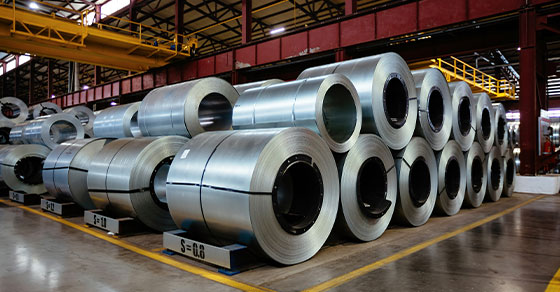Did you know that stainless steel exists in every corner of modern life? It covers kitchen countertops, hospital surfaces, appliances, fixtures, and public buildings.
However, in the industrial sector, stainless steel takes on a more essential role as there is constant demand to perform because machines operate at high temperatures while moving rapidly without interruption.
The selection of materials also extends beyond convenience because it determines equipment performance, maintenance requirements, facility cleanliness, and safety standards. A wrong material choice can lead to higher maintenance and unexpected downtime.
This guide explains why stainless steel continues to lead the way in industrial equipment manufacturing. It also covers what the material is made of and how different grades work.
What is stainless steel made of?
Stainless steel begins with iron, combined with at least 10.5% chromium to form an invisible layer that protects the metal beneath from moisture, air, and rust.
Other elements like nickel, molybdenum, and manganese are added to improve strength, flexibility, and resistance to extreme heat and chemicals. The finish process becomes a tough, low-maintenance metal that doesn’t crack, chip, or rust easily.
The Difference Between 304 and 316 Stainless Steel
Two of the most widely used types of stainless steel are 304 and 316. At first glance, they look the same, but the difference shows up in performance.
304 is the general-purpose option. It is strong, easy to shape, and works well in clean, dry spaces.
316 is made for harsher conditions. It includes molybdenum, which boosts corrosion resistance against salt, chemicals, and moisture. This is why 316 is common in marine environments, food plants, and chemical processing.
The choice between them depends on where the equipment will go and what kind of exposure it will face. Below are the reasons why stainless steel is widely used for manufacturing industrial equipment.
1. Exceptional durability for long-term use
Heavy-duty environments demand materials that don’t break down under pressure. Stainless steel is built for that kind of work. It holds its shape under impact and resists bending, cracking, and warping. It also handles repeated use without wearing out quickly.
This kind of durability matters in manufacturing, mining, food processing, and industrial fabrication. In places where machines run all day or where parts face vibration, moisture, or shifting loads, strong materials save time and money.
The structure of stainless steel helps it absorb stress over long periods. It doesn’t fatigue like softer metals. Even after years of use, equipment built from stainless steel performs reliably.
2. Superior corrosion resistance in harsh environments
Moisture ruins metals and chemicals speed up the damage, but stainless steel manages both without breaking down. This is only possible through corrosion resistance. The chromium in stainless steel forms a thin layer that shields the surface from rust, acid, and chemical reactions.
In marine operations, food production, and chemical plants, this protection is important. Saltwater, cleaning agents, and reactive materials can easily eat through ordinary metal in months; stainless steel stays strong for years.
The inbuilt corrosion resistance doesn’t need extra coatings or treatments, even in the harshest work zones.
3. Supports strict cleaning and hygiene standards
Cleanliness isn’t a bonus in some industries; it is a strict rule. In pharmaceuticals, food processing, medical labs, and cleanrooms, even a small contamination can cause big problems.
Stainless steel makes sanitation easy. The surface is smooth and non-porous. It doesn’t trap dirt, bacteria, or chemicals, and manages cleaning without breaking down. During intense cleaning like pressure washes, high temperatures, and harsh detergents, stainless steel manages to be strong without reacting.
This is why equipment like sinks, tables, tanks, conveyors, and tools in high-risk environments are built with stainless steel. It makes them durable and in line with strict modern hygiene standards and maintenance.
4. Cost-effective over its lifespan
Stainless steel appears costly at first, but its long-term operational performance reveals a different financial picture. The material withstands both wear and heat exposure, as well as chemical substances and moisture. The built-in corrosion protection eliminates the need for repairs and rust maintenance, and reduces unexpected parts breakdowns.
The cost savings begin at this point. The frequency of repairs decreases, while maintenance personnel need to spend less time on fixing deteriorated equipment parts. Full replacements are rare. The reliability of this material reduces operational expenses while minimizing waste production and maintaining minimal downtime.
The durability of steel surpasses its strength because it provides both long-term investment returns and extended service life. The initial investment provides years of service, especially when operating in harsh or high-use conditions.
5. Recyclable and sustainable
Many industries now choose materials that reduce waste and support long-term goals. Stainless steel fits perfectly into that shift as it is 100% recyclable. When reused, strength, finish, and quality remain intact.
Old parts, scraps, or off-cuts can all go back into production, thus supporting cost control and environmental responsibility. This also helps businesses meet modern hygiene standards and sustainability benchmarks without sacrificing performance.
Nu-Tech Metals Use Stainless Steel to Build What Lasts
Good equipment is like a strong backbone. It holds everything up and never draws attention to itself unless it fails, hence why Nu-Tech Metals builds with stainless steel from the ground up.
Every system is custom-built in-house. The team fabricates, supplies, and installs everything, thus cutting delays, reducing handoffs, and staying in full control of each step.
Dust control systems, belt covers, sheeting, sliding, and air handling units are just a few examples of some of the equipment and products we have manufactured with stainless steel.
Durability is always factored in during the design process. This is why all equipment made by us doesn’t crack, warp, or give in easily. Surfaces hold up against moisture, chemicals, and heavy cleaning.
When operations require sterile tools and smooth finishes, our steel products’ hygiene standards are solid. Reach out to us at +1 807-697-4841 or contact us online to talk directly with our team for quotes or a consultation





